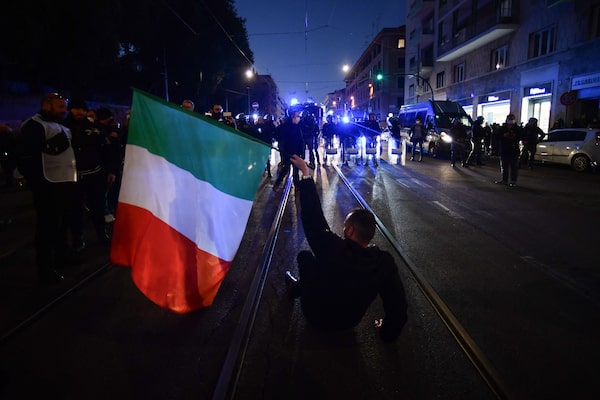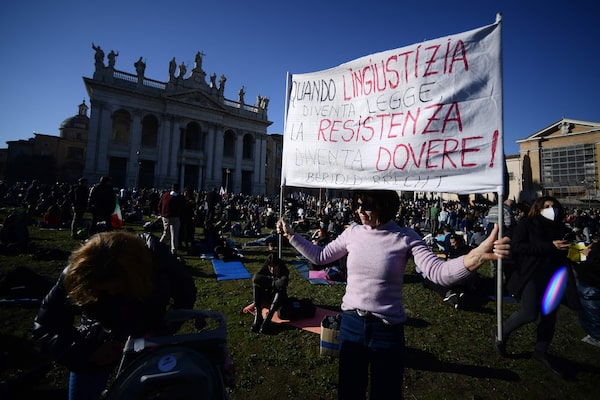
A protester against Italy's so-called Super Green Pass sits in front of riot police near Rome's Piazza San Giovanni on Jan. 10, the day Italy's latest vaccine passport rules took effect. It bars unvaccinated people from restaurants gyms, public transit and sport events.FILIPPO MONTEFORTE/AFP via Getty Images
Table of contents • Latest entries • 2020 diary • 2021 diary
Latest diary entries

The author sports a black eye after a bike crash along the Tiber River in Rome.Eric Reguly/The Globe and Mail
Sunday, Dec. 12
19,215 new COVID-19 cases, 284,877 actual positives, 66 new deaths. Personal fear factor (out of 10): 4
A week or two ago, none of the members of my biking squad, Serie B Biking, had heard of the Omicron variant (the name of our squad is an ironic reference to the second division of Italian soccer). Today, we are well aware that Omicron numbers are exploding and risk one last pre-Christmas roll.
Five of us set out from central Rome and head north to the town of Formello. When we return exhausted after our 75-kilometre ride, I lose control of my bike and crash hard on the wide path running along the Tiber, breaking my left clavicle and knocking myself unconscious for 10 minutes.
I wake up in a crowded hospital emergency ward, but all I can think of is Omicron. I am gripped with fear that I will contract the virus, so I decide to bolt but cannot move because of the pain. I spend the night and, to the doctors’ reproach, check myself out the next day, barely able to walk. My anxiety levels plummet once I drag my broken carcass into the open air.

Rome, Jan. 10, 2022: A banner reads 'when injustice becomes law, resistance becomes duty' at a protest against the vaccine passport system.FILIPPO MONTEFORTE/AFP via Getty Images
Monday, Jan. 10
60,618 new positives, two million actual positives, 227 new deaths. Personal fear factor: 6
I usually begin my day at our local coffee bar, actual newspapers in hand, just around the corner from our apartment on Rome’s San Saba hill, near the Circus Maximus.
The pandemic routine never varies for me. I wait until the bar is free, or largely free, of clients, then enter wearing an N95 mask to order a cappuccino. I take it to an outside table (no snow here, fellow Canadians).
Today the drill is somewhat different, because clients are now required to show proof of vaccination, not just proof of a recent negative test. I open my phone to display the Green Pass QR code, showing a record of my third shot.
A few seconds later, a middle-aged woman, apparently homeless, comes in wearing a mask. She doesn’t order a coffee and asks to use the bathroom. The friendly barista says, “Certo” – certainly – and asks to see her Green Pass. She doesn’t have one, and the barista asks her to leave. She doesn’t put up a fuss and walks out, looking dejected.
The barista’s view is that unvaxxed clients should not be allowed to endanger other clients. But I feel sorry for her. Would I have asked this desperate woman to go if I were the barista? I don’t know.
Tuesday, Jan. 11
129,542 new positives, 2.1 million actual positives, 294 new deaths. Personal fear factor: 7
Today I am under vicious attack and I don’t understand why. All I did was write an 800-word article for The Globe and Mail about several European countries launching, or about to launch, mandatory vaccine programs, as Italy has done for people 50 and over.
While I am a columnist, the article took no editorial position; it was just straight reporting and carried the headline: “Support growing among European governments for vaccine mandates.”
From the vicious reaction of the anti-vax crowd, you would have thought I had bought national airtime to spout the view that vaccines should be mandatory for everyone and that all skeptics, or “refuseniks” as they have been called, should be incarcerated on a remote Pacific island.
For days my Twitter feed is stuffed with hundreds of nasty comments about me. One gracious writer said, “I’d like to throw every vaccinated nut like you into a gas chamber” (the second line of his tweet is unprintable).
The attacks actually don’t upset me; they make me realize that a small but determined part of the adult population will never get vaxxed, potentially prolonging the pandemic.

Rome, Jan. 16: Masked spectators wait for a soccer match between AS Roma and Cagliari at the Olympic stadium.FILIPPO MONTEFORTE/AFP via Getty Images
Sunday, Jan. 16
78,010 new positives, 2.5 million actual positives, 248 new deaths. Personal fear factor: 7
The Italian press reports that Luigi Marilli, 63, leader of the anti-vax, no-Green Pass movement in Abruzzo, the region due east of Rome, has died of COVID-19 in a hospital in Pescara. His supporters anounce his death of Facebook but don’t mention what caused it.
Tuesday, Jan. 18
6,878 new positives, 2.6 million actual positives, 434 new deaths. Personal fear factor: 6
The number of new daily positives, if not deaths, is coming down, having apparently peaked at more than 172,000 on Jan, 6. So I wonder why we – that is, my family and I and many of our friends– are still living as if we are in effective lockdown. In our case, we never meet anyone indoors for a meal or coffee. We never visit friends inside their homes. All our groceries are delivered. While I often go out for coffee, I always drink it on the sidewalk tables. When our cleaner comes, we open all the windows of the apartment and put on masks.
We live in one of the world’s most beautiful cities and never use it. I wonder if we are overreacting to the Omicron wave and don’t have an easy answer, though it occurs to me that the way we live could simply be out of habit. We endured almost two years of pandemic in Italy, one of the worst-hit countries, without getting infected and have become accustomed to our defensive, indoor lifestyle.
Rome as a packed, vivacious, friendly, culturally rich city seems like a dream to me. Might be time to rediscover it – but only if the numbers co-operate. There I go again: The fear factor always wins.
COVID-19: More from The Globe and Mail
The Decibel
How are scientists tracking the mutations of COVID-19 variants like Omicron to learn what they might do to populations next? Globe science reporter Ivan Semeniuk explains. Subscribe for more episodes.
Explainers
Omicron symptoms mirror the flu and cold. What should I do if I feel sick?
How many COVID-19 cases are there in Canada and worldwide? The latest maps and charts
 Eric Reguly
Eric Reguly